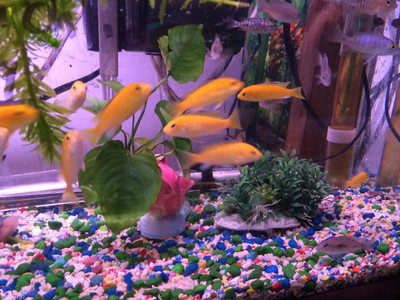Unveiling the Radiant Beauty of the Electric Yellow Lab Cichlid: Sunshine in Your Aquarium
Posted by Max Gandara on on 2nd Apr 2024
Appearance and Identification
The Electric Yellow Lab Cichlid is instantly recognizable by its brilliant yellow coloration, which resembles the warm glow of sunshine in an aquarium setting. This stunning hue extends from its head to its tail, with shades ranging from pale lemon to deep golden yellow, depending on factors such as age, sex, and mood.
In addition to its striking coloration, the Electric Yellow Lab features a sleek, torpedo-shaped body and a distinctive black dorsal fin edged in white. Juveniles may exhibit faint black markings on their bodies, which tend to fade as they mature into adulthood. Adult specimens typically reach lengths of around 3 to 4 inches (7.5 to 10 centimeters), making them suitable for smaller to medium-sized aquarium setups.
Natural Habitat
Native to the rocky shores and sandy substrates of Lake Malawi in East Africa, the Electric Yellow Lab Cichlid inhabits shallow waters with ample hiding places and rocky outcrops. In its natural habitat, it can be found foraging for food among the crevices of rocks and seeking shelter among submerged vegetation.
Water conditions in Lake Malawi are typically warm and alkaline, with temperatures ranging from 75°F to 82°F (24°C to 28°C) and pH levels between 7.8 to 8.6. Aquarists seeking to replicate their natural environment should aim for similar parameters in their aquariums, along with moderate hardness and ample water movement.
Aquarium Care
Keeping Electric Yellow Lab Cichlids in captivity is relatively straightforward, provided their basic care requirements are met. Here are some essential care guidelines:
- Tank Size: Provide a spacious aquarium with ample swimming space and hiding places. A minimum tank size of 30 gallons is recommended for a small group of Electric Yellow Labs, although larger tanks are preferred for larger groups or community setups.
- Water Parameters: Maintain stable water conditions with temperatures between 75°F to 82°F (24°C to 28°C), pH between 7.8 to 8.6, and moderate to high hardness. Regular water changes and proper filtration are essential for maintaining water quality and oxygenation.
- Substrate and Decor: Use a sandy substrate or fine gravel to mimic the sandy bottoms of Lake Malawi. Provide plenty of rocky caves, driftwood, and hiding places to create a naturalistic environment and reduce stress. Avoid sharp decorations or abrasive substrates that could injure the fish.
- Diet: Electric Yellow Lab Cichlids are omnivorous and will readily accept a variety of foods. Offer a balanced diet consisting of high-quality pellets, flakes, and occasional treats such as frozen or live foods like bloodworms, brine shrimp, and small insects. Feed them small portions multiple times a day to prevent overfeeding and ensure optimal nutrition.
- Compatibility: Electric Yellow Lab Cichlids are generally peaceful and can be kept with other similarly sized and temperamented species from Lake Malawi, such as other mbuna cichlids and peaceful African cichlids. Avoid housing them with aggressive or predatory species that may harass or intimidate them.
Breeding Behavior
Breeding Electric Yellow Lab Cichlids in captivity is relatively easy, as they are prolific breeders under the right conditions. To encourage spawning behavior, provide plenty of rocky caves or flat surfaces for the females to lay their eggs. Males may establish territories and display vibrant colors to attract potential mates.
Once spawning occurs, the female will deposit her eggs on a cleaned surface within the aquarium, where the male will fertilize them. The parents will guard the eggs and fry until they are free-swimming, at which point they can be separated from the adults or left to fend for themselves in a community tank.
Conclusion
In the vibrant world of freshwater aquariums, few fish rival the radiant beauty and charm of the Electric Yellow Lab Cichlid. With its dazzling golden coloration, peaceful demeanor, and ease of care, this species continues to captivate and inspire aquarists of all levels of experience. By providing proper care, attention, and appreciation for these magnificent fish, enthusiasts can experience the joy and wonder of bringing a ray of sunshine into their own aquatic realms.

